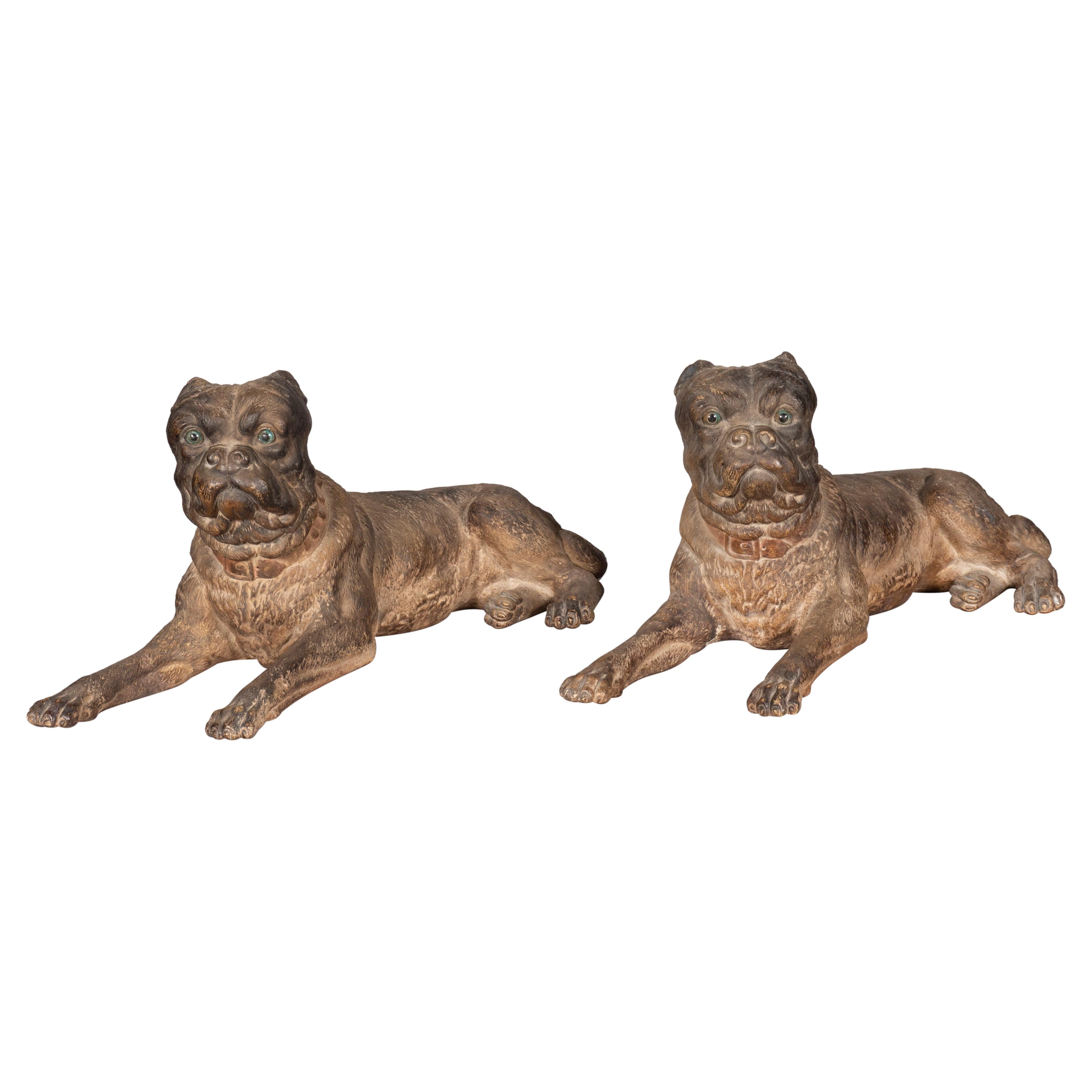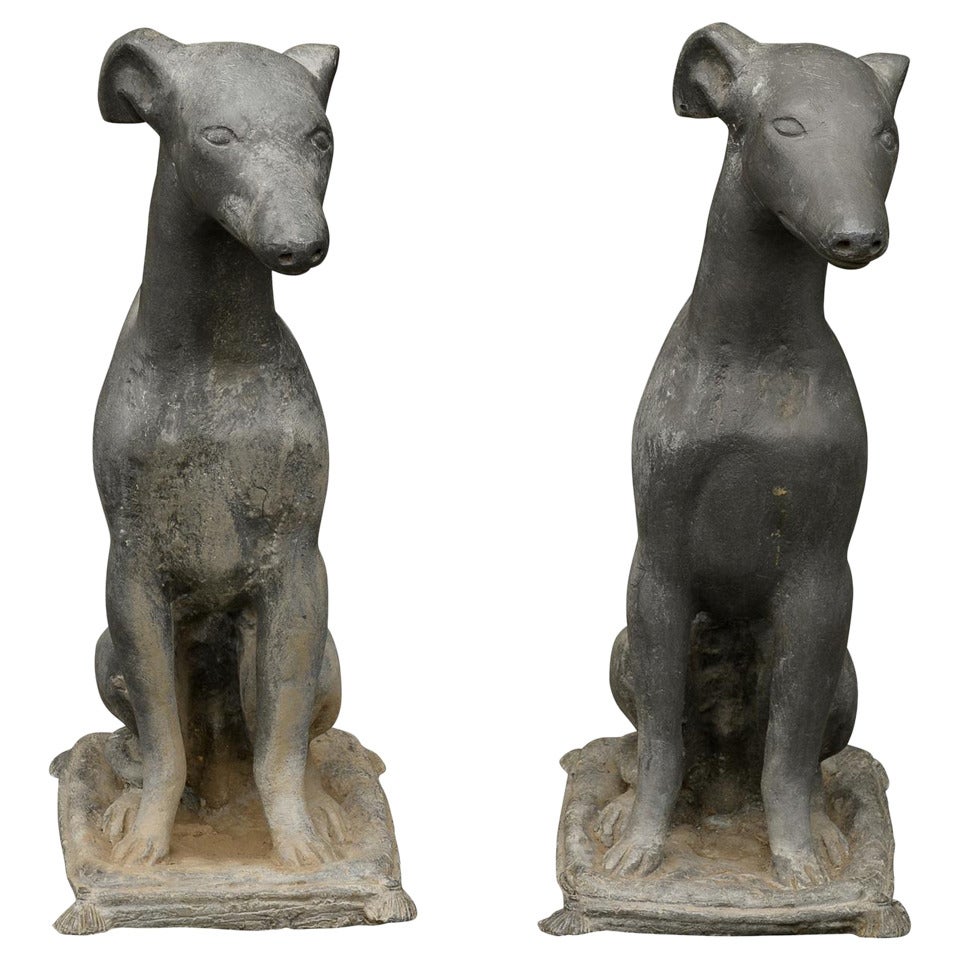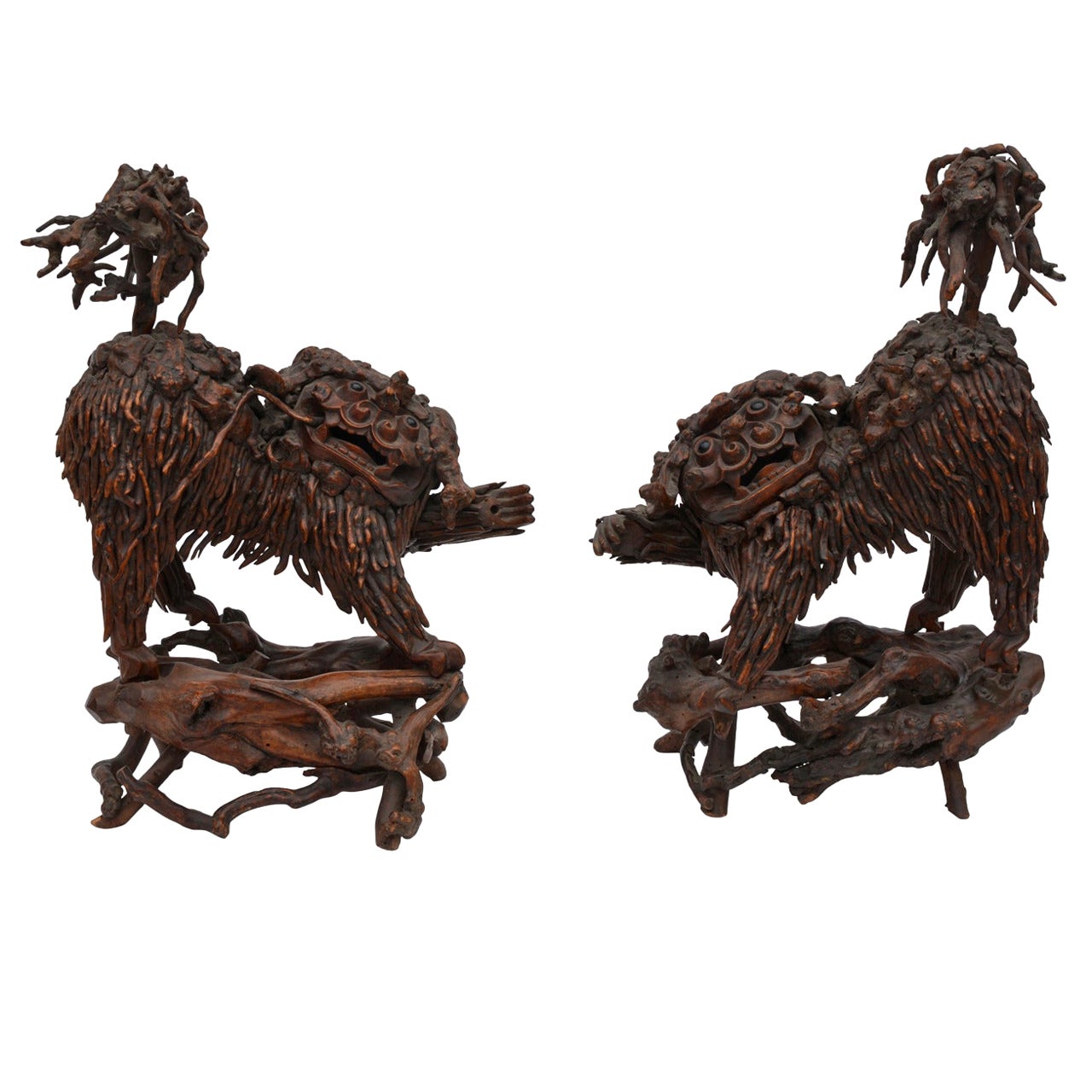Items Similar to Rare Pair of Venetian Sitting Mastiffs Dogs
Want more images or videos?
Request additional images or videos from the seller
1 of 12
Rare Pair of Venetian Sitting Mastiffs Dogs
About the Item
Rare pair of sitting Mastiffs dogs.
Venice, end of 15th century - first half of the 16th century.
Istrian stone.
Provenance:
- Important private collection of an architect and scenographer from Orvieto (Umbria)
A regular exportation licence delivered by the Italian Ministry of Culture accompanies the work.
The representation of the dog dates back to ancient times, when dogs were considered weapons of war and used to attack the enemy or stand guard to protect strategic locations. At the entrance to the Pompei’s villa, the presence of a "cave canem" inscription was enough to discourage potential thieves.
During the Renaissance, the figure of the dog took on new meanings.
Loyalty was only one of the many virtues attributed to the mastiffs: benignity, strength and persuasiveness made the dog the symbol of the prince's virtues.
Head of the herds, the dog also symbolized the Christian Faith and made allegorical reference to the role of the Prince as a Good Shepherd.
The noble animal (the trilogy horse - dog - hunting bird) is one of the identifying elements of medieval or modern aristocracy. The noble animal is essential for a certain aristocratic ostentation. The dog is assimilated to the man who sports it and of which it becomes an extension.
He is then invested with a function of representation: through his symbolic and pecuniary value as well as his appearance and character, he embodies the qualities of his master and in return he projects onto his owner those that the collective imagination attributes to him.
However, the dog was not only considered as a companion, or part of man’s environment, but as an individual having its own nobility, its own identity.
From this perspective, the dog is seen as "absolute otherness" with which man develops and maintains relationships of reciprocity and interdependence. This Other, offers man his own reflection. Sometimes a distorting mirror, sometimes an exemplary representation, the animal world is subject to the same hierarchy that characterizes human society.
These two dogs with their nervous musculature and theirs thin skin showing theirs sides are represented seated, in an austere and frontal position which alludes to their role of faithful guardians.
The heads are large, the eyes set well apart, the limbs long and robust; theirs thick and pointed necklaces reaffirm their strength.
Made of Istrian stone, typical Venetian stone, the pair of mastiffs we present were probably enthroned at the entrance of an historic villa around Venice to allude to the virtues of strength and determination of the Lord of the Castle.
During the XV-XVI century, Venice was becoming more aristocratic and less republican. Noble families wanted to display their wealth and dog were a sign of high social status which explains why images of dogs become much more common in sculptures and paintings. Their status of objects of favor and prestige among the European ruling families and their owners’
desire for conspicuous display, particularly among the Italian ducal families resulted in a demand for portraits of individual dogs. Most memorably in Mantegna’s Camera Picta (1465-1474) where the Marquis of Mantua’s favorite dog Rubino is under his chair. The dog’s evidence a changing society and their new popularity mirroring an increasingly aristocratic Venice.
No other Cinquecento ideal could merge the concepts of beauty, elegance and renunciation of earthly goods better than the mastiff. The dog therefore had to represent the ideal animal, a harmonious synthesis of honor, fidelity, tenacity: essential characteristics to be the ideal servant of the good prince.
Even the Granduke Cosimo II commissioned from the most important animal sculptor of his century, Matteo Ferrucci del Tadda, a set of 48 animals, including 11 stone mastiff dogs ("cani grossi europei") which were intended for the New Amphitheater of Palazzo Pitti, conceived between 1611 and 1637 by Michelangelo Bonarroti. In 1661 the sculptures were moved to the Boboli Gardens to complete the allegorical cycle celebrating the virtues of the family and the prince.
Bibliography:
- E. P. Bowron, « An artist’s best friend: The dog in Renaissance and Baroque Painting and Sculpture », in Best in show: The dog in Art from the Renaissance to Today, Yale University Press Association with the Museum of Fine Arts, Houston and the Bruce Museum of Art and Science
- G. Capecchi, I Cani in pietra bigia di Romolo Ferrucci del Tadda, simbolismo e capriccio nel giardino di Boboli, Firenze 1998
- J. Derrida, L’animal que donc je suis, Paris, Galilée, 2006
- « Noblesse de l’animal, noblesse par l’animal dans la péninsule Ibérique et l’Amérique Latine (Moyen Age, siècle d’or) », Bordeaux, Université Bordeaux Montaigne, 18-19 mars 2021.
- Dimensions:Height: 35 in (88.9 cm)Width: 13 in (33.02 cm)Depth: 21 in (53.34 cm)
- Sold As:Set of 2
- Style:Renaissance (Of the Period)
- Materials and Techniques:
- Place of Origin:
- Period:
- Date of Manufacture:circa 1480-1530
- Condition:Wear consistent with age and use.
- Seller Location:Bruxelles, BE
- Reference Number:1stDibs: LU6666229307912
About the Seller
5.0
Vetted Seller
These experienced sellers undergo a comprehensive evaluation by our team of in-house experts.
1stDibs seller since 2022
6 sales on 1stDibs
Typical response time: 7 hours
- ShippingRetrieving quote...Ships From: Bruxelles, Belgium
- Return PolicyA return for this item may be initiated within 3 days of delivery.
More From This SellerView All
- Group of Altarpiece - Antwerpen, 16th centuryLocated in Bruxelles, BEGroup of altarpiece representing the life of a Saint, Saint Renualde? Engraved by the sign of Antwerp hand on the hat of the central character Carved oak, traces of polychromy Fir...Category
Antique 16th Century Belgian Renaissance Figurative Sculptures
MaterialsOak
- Adoration of the Magi, Flanders, 17th CenturyLocated in Bruxelles, BEThe Adoration of the Magi. Panel carved in high relief. Flanders, 17th century. Measures: 53 x 32,5 cm.Category
Antique 17th Century Dutch Renaissance Figurative Sculptures
MaterialsWood
- Hercules Holding a Coat of Arms, Flemish, XVII CenturyLocated in Bruxelles, BEHercules holding a coat of arms Flemish, XVII century White and black marble Measures: 67 x 32 x 19 cm Hercules is depicted naked, holding a coat of arms with the right hand an...Category
Antique 17th Century Belgian Renaissance Figurative Sculptures
MaterialsMarble, Belgian Black Marble
- Cercle of Romano Alberti, Page, Around 1530-1540Located in Bruxelles, BECercle of Romano Alberti, dit Il Nero da Sansepolcro ( San Sepolcro, 1521-1568 ) Page Mixed media : wood core, papier mâché, stucco, polychrome and gilded Italy, around 1530-154...Category
Antique 16th Century Italian Renaissance Figurative Sculptures
MaterialsStucco, Wood, Paper
- Massacre of the Innocents, Normandy, Late 16th CenturyLocated in Bruxelles, BEThe Massacre of the Innocents Carved oak panel Normandy, late 16th century (Collection labels on the back) Measures: 43,5 x 61 cm.Category
Antique 16th Century French Renaissance Wall-mounted Sculptures
MaterialsOak
- Cercle of Jacopo della Pila - Marble relief depicting a winged CherubLocated in Bruxelles, BECercle of Jacopo della Pila (Lombard, in Naples 1471-1502) Marble relief depicting a winged Cherub Naples, second half of15th century 40 x 57 x 12 cm Exquisitely carved, this relief portrays a winged cherub with cascading hair and delicate features. The cherub's plump, smooth countenance, rounded cheeks, outlined lips, and finely drawn nose emanate a sense of tenderness. The quadrangular module, is adorned with a carved frame. The relief ascends gradually, transitioning from the low relief of the wings to the high relief of the head. The rectangular frame and the subtly curved form of the artwork suggest that the relief likely adorned the upper part of an arch or a vaulted chapel. The type is that of the perspective room with a coffered ceiling decorated with figures of winged cherubs, which is found in various Neapolitan chapels of the 15th century. Coffered ceilings attest to the recovery of antiquity and the search for luxury in Renaissance architecture, first in Florence, then in Rome and Naples. The majority of the numerous family chapels and tombs built during the late fifteenth century in south of Italy employ the new formal vocabulary of the Florentine Renaissance in a self-confident manner that permitted a broad spectrum of variations. The escalating admiration for the classical world, coupled with the development of perspective, significantly contributed to the Renaissance endorsement of coffered ceilings. This artistic and constructive device drew inspiration from the intricate marble patterns observed in historical landmarks such as the Arch of Titus, the Temple of Vesta in Tivoli, the Pantheon, and the Basilica of Maxentius. A distilled product of both mathematical and artistic cultures, deeply scrutinizing the ancient world, the coffered ceiling plays a vital role in the perspective construction of space with its regular and directional geometry. The motif of the coffered ceiling decorated with cherubs in relief was introduced in Naples by Francesco Laurana in the plastic decoration of the Arch of Castelnuovo. Laurana's impact on the art scene in the south of Italy was profound. The introduction of the winged cherub into the region's artistic vocabulary bridged the gap between the classical and the contemporary, creating a synthesis that resonated with both aesthetic and spiritual sensibilities. His influence extended beyond the immediate visual appeal, shaping the cultural identity of the Renaissance in southern Italy. Although the plastic decoration of the Arch of Castelnuovo cannot certainly be ascribed to a mature Renaissance style, it was precisely on this occasion that the sculptors who worked there could get to know and export throughout the Italian peninsula that type of "Florentine classicism" which, even in the 15th century Naples, was conditioned by the Burgundian culture imported into the Kingdom by Alfonso of Aragon himself, with artists called from Spain and Northern Europe. The coffered ceiling, with its geometric patterns and Laurana's winged cherubs nestled within, became a symbol of refinement and cultural sophistication. The relief sculptures, carefully integrated into the overall design, transformed the ceiling into a celestial realm, inviting viewers to contemplate the divine while immersed in the grandeur of the Renaissance space. Similar winged cherubs appears also in the Naples cathedral. Within the renowned Succorpo Chapel, a mesmerizing marble coffered ceiling adorned with cherubs epitomizes the splendor of the Neapolitan Renaissance. The interplay of light and shadow on the textured surface of the marble coffered ceiling introduces an ethereal dimension, providing an immersive visual experience for observers. The geometric precision and the repeated patterns, reminiscent of classical motifs, establish a sense of harmony and balance that has become the hallmark of the Neapolitan interpretation of Florentine Renaissance aesthetics. Although probably intended to be admired from a distance, this cherub is intricately detailed and exquisitely rendered: the face and hair are elegantly outlined and the feathers are textured through juxtaposed lines. The marble, both figurative and decorative, adheres to the principles of balance and restrained ornamentation typical of the « Florentine Classicism ». Harmonious shapes and gracefully orchestrated curves , rooted in the classical repertoire, converge to evoke a sense of ethereal beauty. The surface displays the masterful use of a chisel to intricately carve the feathers and facial features, creating an almost abstract quality. This work is a testament to a sculptor of great skill and rich figurative knowledge, seamlessly blending classical firmness in contours with a refined treatment of the marble's surface. The combination of tradition and innovation point to a stylistic idiom from Lombardy, in particular we can find some comparaisons with the works of Jacopo della Pila, sculptor of Lombard origin working in Naples in the second half of the 15th century. He is documented there between 1471 and 1502, and is a protagonist of the Aragon Renaissance in the second half of the Quattrocento, together with the other great Northern sculptor active in the kingdom, Domenico Gagini. the first commission he received dates back to August 9, 1471, when Jacopo publicly committed to sculpting the funerary monument of Archbishop Nicola Piscicelli to be placed in the Cathedral of Salerno. The last known work is an altar ordered on July 29, 1502, by the noble Jacopo Rocco for the church of San Lorenzo Maggiore in Naples. Between these two chronological extremes (1471-1502), we must place the fervent activity of the artist, who had trained in Rome, perhaps under the guidance of Paolo Romano but also engaged in dialogue with other major artists of the city, especially Isaia da Pisa. He enriched his experience in Naples, initially drawing inspiration from the works of Domenico Gagini and later from the Tuscan masterpieces of Antonio Rossellino and Benedetto da Maiano destined for the church of Santa Maria di Monteoliveto. Jacopo della Pila's artistic personality is thus based on a complex interplay of influences, contributing to the definition of a highly personal style. Close comparaison can be made between our cherub and the winged angels reliefs...Category
Antique 15th Century and Earlier Italian Renaissance Figurative Sculptures
MaterialsMarble
You May Also Like
- Pair of Large Terracotta Mastiff DogsLocated in Essex, MAEach in a reclining position. Glass eyes. Incredibly detailed with a few old repairs to the legs.Category
Antique Late 19th Century European Animal Sculptures
MaterialsTerracotta
- Pair of American 1930s Lead Greyhound Dogs Sculptures Sitting on CushionsLocated in Atlanta, GAA pair of midcentury American lead dogs, obediently sitting on cushions. This adorable pair of dogs, circa 1930, was born in the United States and features t...Category
Mid-20th Century American Art Deco Animal Sculptures
MaterialsLead
- Pair of Rare Chinese Carved Wood Foo DogsLocated in Los Angeles, CAPair of rare Chinese carved wood foo dogs.Category
Antique 18th Century Chinese Chinoiserie Animal Sculptures
MaterialsWood
- Pair of Rare Chinese Carved Wood Foo DogsLocated in Los Angeles, CAPair of rare Chinese carved wood foo dogs.Category
Antique 18th Century Chinese Chinoiserie Animal Sculptures
MaterialsWood
- Pair of American Cast Stone & Painted Labrador Sitting Dogs, Early 20th CenturyLocated in Hollywood, SCPair of American cast stone and painted Labrador dogs in sitting position resting on flanking rectangular plinths. Plinth measurements are 9" wide and 15" Deep. Early 20th century.Category
Early 20th Century American American Empire Animal Sculptures
MaterialsCast Stone
- Pair of Porcelain DogsLocated in Greenwich, CTPair of porcelain dogs. Well models.Category
Late 20th Century Asian Chinese Export Animal Sculptures
MaterialsPorcelain
Recently Viewed
View AllMore Ways To Browse
Used School Furniture
Venetian Furniture
Antique School Furniture
By Venetian
Antique Sitting Room Furniture
Venetian Antique
Antique Venetian
Antique Venetian Furniture
Pair Of Venetian
Italian Sitting Room
Pair Thin
Venetian Carved
Black Venetian
Venetian Set
Entrance Pair
Venetian Master
Venetian Baroque
Rare Mirror Black





